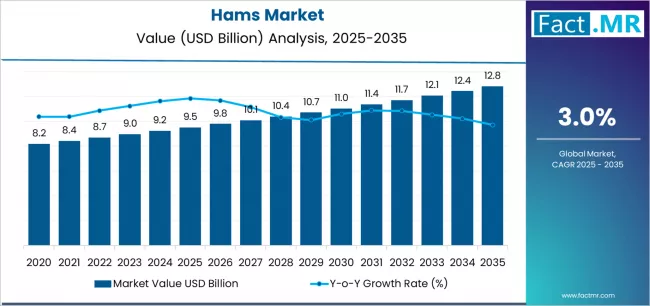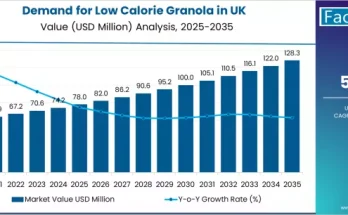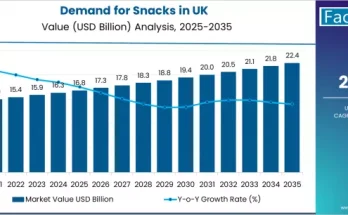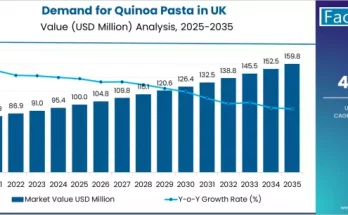The global hams market is forecast to grow from USD 9.5 billion in 2025 to USD 12.8 billion by 2035, representing a compound annual growth rate (CAGR) of around 3.0%. This growth reflects the rising demand for ready-to-eat protein, premium and convenience meat options, and expanding retail and foodservice distribution in global markets.
As lifestyles shift toward greater convenience and high-protein diets, processed ham products are emerging as a mainstream staple. Demand is especially strong for cooked/boneless varieties, which offer ease of use, long shelf life, and broad culinary versatility.
Key Market Insights at a Glance
-
2025 Market Value: USD 9.5 billion
-
2035 Forecast Value: USD 12.8 billion
-
Expected CAGR (2025–2035): ~3.0%
-
Leading Product Segment: Cooked / Boneless Ham (~52% share)
-
Top Distribution Channel: Retail (~66% share)
-
Key Regions Driving Growth: North America, Europe, Asia Pacific
-
Major Players: WH Group, Hormel Foods, Tyson Foods, Campofrío, JBS
To Access the Complete Data Tables & in-depth Insights, Request a Discount on this report: https://www.factmr.com/connectus/sample?flag=S&rep_id=4827
Five Key Drivers Fueling Market Growth
-
Growing Preference for Convenient, Ready-To-Eat Proteins
Consumers increasingly favor pre-cooked, boneless hams that can be easily sliced, served cold, or used in sandwiches and home meals — driving uptake in both retail and foodservice. -
Premiumization & Quality Innovation
Demand for gourmet and dry-cured ham is rising, driven by consumer interest in artisanal, flavorful, and higher-margin protein options. -
Expanding Retail Penetration
Supermarkets, convenience stores, and modern grocery formats are scaling up ham assortments for value, premium, and specialty products, supporting broader market access. -
Urbanisation & Protein-Rich Diet Trends
As disposable incomes grow and urban populations increase, consumers are buying more value-added meat products like ham as part of balanced, protein-focused diets. -
Sustainability & Efficiency in Production
Producers are optimizing processes — including slicing, packaging, and cold-chain logistics — to deliver better-quality ham with lower waste and stronger environmental credentials.
Regional Outlook
-
North America: Leading region with high per capita consumption of processed meats, strong retail chains, and demand for premium and convenience-style hams.
-
Europe: Mature market with strong adoption of traditional, dry-cured, and specialty ham products, coupled with strict standards for food safety and quality.
-
Asia Pacific: Emerging as a key growth region — rising urbanisation, changing diets, and expanding retail infrastructure are supporting higher ham consumption.
Market Segmentation Highlights
-
By Product Type
-
Cooked / Boneless Ham
-
Dry-Cured Ham
-
Other Ham Variants
-
-
By Channel
-
Retail (Supermarkets, Grocery Stores)
-
Foodservice (Restaurants, Hotels, Catering)
-
Online / E-commerce
-
-
By Source
-
Conventional (Standard Production)
-
Organic / Antibiotic-Free
-
Challenges & Restraints
-
Production Complexity & Cost: High standards for curing, slicing, and packaging can increase production costs.
-
Food Safety & Regulatory Compliance: Stringent hygiene and preservative regulations add to operational complexity.
-
Consumer Health Concerns: Processed meat consumption is under scrutiny for sodium content, preservatives, and processed food risks.
-
Supply Chain Dependency: Efficient cold-chain and retail logistics are critical, especially for perishable ham products.
Recent Trends & Developments
-
Increasing innovation in low-sodium, nitrate-free, and organic ham varieties.
-
Expansion of pre-sliced, portion-controlled, and vacuum-packed ham formats for retail convenience.
-
Strategic collaborations between ham producers and retailers to modernize merchandising and improve shelf visibility.
-
Growth of e-commerce and online grocery platforms offering specialty and premium ham products.
-
Adoption of sustainable processing practices, including energy efficiency and waste reduction, in ham production.
Competitive Landscape
Key industry players — such as WH Group, Hormel Foods, Tyson Foods, Campofrío, and JBS — are leveraging their scale, processing expertise, and distribution networks to expand in both conventional and premium segments. These companies are:
-
Investing in R&D for value-added ham products
-
Expanding production capacity in high-growth regions
-
Partnering with retailers to optimize product placement and merchandising
-
Focusing on sustainability and traceability in their supply chains
-
Exploring inoculation of convenience and ready-to-eat formats for changing consumer habits
Market Outlook & Strategic Insights
Looking ahead to 2035, the hams market is expected to continue rising steadily as convenience, taste variety, and protein-rich diets gain greater importance. Key strategic imperatives for stakeholders include:
-
Enhancing supply-chain resilience and cold-chain logistics
-
Innovating in clean-label, health-conscious, and premium ham offerings
-
Expanding presence in emerging markets through local partnerships and tailored products
-
Strengthening retail engagement and merchandising strategies
-
Investing in sustainable production and traceability to build consumer trust
➤Browse Full Report: https://www.factmr.com/report/4827/hams-market
Have specific requirements or need assistance on report pricing or have a limited budget? Please contact sales@factmr.com
About Fact.MR:
Fact.MR is a global market research and consulting firm, trusted by Fortune 500 companies and emerging businesses for reliable insights and strategic intelligence. With a presence across the U.S., UK, India, and Dubai, we deliver data-driven research and tailored consulting solutions across 30+ industries and 1,000+ markets. Backed by deep expertise and advanced analytics, Fact.MR helps organizations uncover opportunities, reduce risks, and make informed decisions for sustainable growth.



